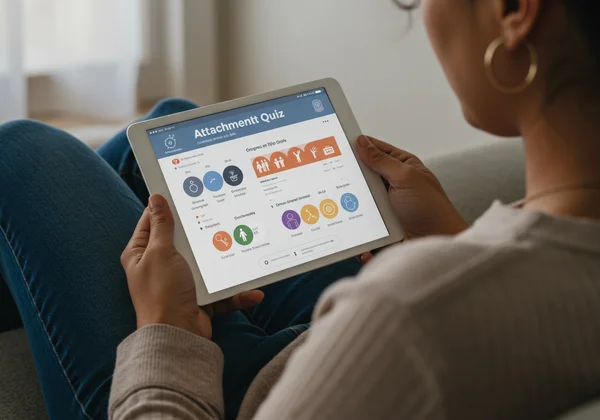How Childhood Experiences Shape Your Attachment Style: A Guide & Quiz
Do you ever find yourself puzzled by your reactions in relationships? Some people seem to sail through intimacy, while for others, it feels like an uphill battle. If you've felt that struggle, you're not alone. The answers often lie hidden in our earliest years. Our childhood experiences create a blueprint for how we connect with others, shaping our adult attachment style. What is my attachment style, you might ask? This question is the first step toward profound self-understanding and healthier relationships.
Here, we'll dive into the profound link between your childhood and your current relationship patterns. Let's trace back to where your emotional responses began, offering insights into why you love, connect, and sometimes struggle the way you do. Understanding this foundation is not about placing blame; it's about empowerment. Once you understand your story, you can begin to write a new chapter. Ready to connect the dots? You can discover your own patterns with our free tool.

The Roots of Your Attachment Style: Early Beginnings
Our journey into understanding adult relationships begins where our own stories did: in infancy. The bonds we formed with our first caregivers laid the groundwork for our entire relational world. This isn't just a poetic idea; it's the core of a powerful psychological framework that explains so much about our adult lives and is central to any attachment style test.
What is Attachment Theory?
First developed by psychologist John Bowlby, Attachment Theory posits that humans are born with an innate need to form a strong emotional bond with at least one primary caregiver. This bond is essential for survival, providing a sense of safety and security. When a child feels safe, they can explore the world confidently, knowing they have a "secure base" to return to in times of distress. The quality of this first bond creates an "internal working model"—a set of expectations and beliefs about ourselves, others, and the nature of relationships that we carry with us throughout life. This model unconsciously guides our behavior in future friendships and romantic partnerships.
The Critical Role of Primary Caregivers
The way our caregivers responded to our needs as infants and toddlers was incredibly formative. Were they consistently available, warm, and responsive to our cries for comfort or attention? Or were they inconsistent, distant, or overwhelming? These early experiences directly shaped which attachment style we developed. A caregiver who reliably meets a child's needs fosters a sense of security. Conversely, a caregiver who is neglectful, inconsistent, or intrusive can lead to the development of insecure attachment patterns, which we will explore next. This early learning becomes the default script for how we seek closeness and handle conflict in adulthood.

How Early Bonds Shape Adult Relationship Patterns
The echoes of our childhood attachment don't just fade away; they resonate powerfully in our adult lives. That internal working model we developed becomes the lens through which we view intimacy, trust, and emotional vulnerability. Understanding these relationship patterns is the key to decoding your own behavior and improving your connections.
Recognizing Secure, Anxious, Avoidant, and Disorganized Traits in Adulthood
These early bonds crystallize into four main attachment styles in adulthood. See if you recognize any of these patterns in yourself or others:
- Secure Attachment: Individuals with a secure style are comfortable with intimacy and interdependence. They trust their partners, communicate their needs effectively, and manage conflict constructively. They value their relationships but also maintain a strong sense of self.
- Anxious Attachment: Often called "preoccupied," those with an anxious style crave closeness but fear their partner doesn't want the same. They can be preoccupied with their relationships, requiring frequent reassurance and worrying about abandonment.
- Avoidant Attachment: Often called "dismissive," individuals with an avoidant style value independence and self-sufficiency above all. They tend to suppress their emotions and may feel uncomfortable with too much closeness, often pulling away when a partner tries to get closer.
- Disorganized Attachment: Sometimes called "fearful-avoidant," this is a more complex style marked by a desire for intimacy that is paired with a deep fear of it. Their behavior can seem contradictory, as they may simultaneously want and push away connection.
If these descriptions spark curiosity, taking a free attachment style quiz is an excellent next step to gain clarity.
![]()
The Interplay of Past Experiences and Adult Intimacy
How does this translate into real life? An individual with an anxious attachment style, whose caregivers were inconsistent, might constantly seek validation from their partner to soothe their deep-seated fear of being left alone. Someone with an avoidant style, who may have learned that expressing needs leads to rejection, might shut down during arguments to avoid feeling vulnerable. Their adult intimacy playbook was written in childhood. Recognizing these connections is the first, most crucial step toward change. It allows you to move from unconscious reaction to conscious choice in your relationships. To see how these patterns play out for you, you can get your results with a detailed assessment.
Beyond Childhood: Understanding & Healing Insecure Patterns
Learning about the childhood attachment origins of our relational struggles can be eye-opening, but it can also feel deterministic. The most empowering truth of attachment theory is that our style is not a life sentence. With awareness and effort, we can heal from past wounds and move toward a more secure way of relating, a concept known as "earned security."
Self-Reflection: Connecting Your Past to Present Behavior
The healing journey begins with honest self-reflection. Start by gently connecting the dots between your past and your present behavior. Ask yourself some guiding questions: What was emotional expression like in my family growing up? How were my needs for comfort and attention met? Do I see a pattern between those early experiences and how I act when I feel vulnerable in my romantic relationships today? This isn't about blaming caregivers but about understanding the "why" behind your reactions. This self-awareness is the foundation upon which you can build new, healthier patterns.
When to Seek Deeper Insights or Professional Support
Self-reflection is powerful, but sometimes we need a more structured tool to see ourselves clearly. This is where a well-designed attachment style quiz can provide invaluable deeper insights. It helps you move from a vague feeling of "something is off" to a specific understanding of your patterns. Our free attachment style quiz is designed as a confidential and supportive first step for this exploration. For those who experience significant distress or feel stuck in painful cycles, seeking support from a therapist who specializes in attachment can be a transformative step. The goal is always to move toward greater self-compassion and healthier, more fulfilling connections. Why not start your journey today?

Your earliest experiences have deeply shaped who you are, particularly in how you relate to others. Understanding your attachment style is like being handed a map to your own inner world. It illuminates the origins of your fears, your desires, and the recurring patterns in your relationships. This knowledge doesn't chain you to your past; it liberates you from it.
By recognizing whether you lean towards a secure, anxious, avoidant, or disorganized style, you gain the power of choice. You can learn to communicate your needs more effectively, build deeper trust, and break free from cycles that no longer serve you. Your journey to more fulfilling relationships starts with this single, powerful step of self-discovery.
Are you ready to understand your unique relationship blueprint? Take our confidential and insightful attachment style quiz free today. It’s the first step towards building the secure, loving connections you deserve.
Frequently Asked Questions About Attachment Styles & Their Origins
What are the 4 types of attachment styles?
The four primary attachment styles identified in adults are Secure, Anxious (or Preoccupied), Avoidant (or Dismissive), and Disorganized (or Fearful-Avoidant). Each style represents a different pattern of behavior and belief about intimacy, trust, and relationships, largely shaped by early life experiences.
Are attachment style quizzes accurate?
High-quality quizzes, like the one offered on our site, are based on established psychological principles from attachment theory. They serve as excellent self-assessment tools to help you identify your dominant patterns and tendencies. While they are not a clinical diagnosis, they provide a highly accurate and valuable starting point for self-awareness and personal growth.
Can an adult's attachment style change?
Yes, absolutely! This is one of the most hopeful aspects of attachment theory. Through self-awareness, intentional effort, and often through experiencing a secure relationship with a partner or therapist, individuals can develop an "earned-secure" attachment style. The first step is always understanding where you are now, which you can do when you find your starting point.
What's the healthiest attachment style?
The secure attachment style is considered the healthiest model for relationships. It is characterized by a positive view of self and others, a balance of intimacy and independence, and the ability to manage conflict constructively. However, the goal is not to achieve perfection but to build self-awareness and move towards more secure behaviors, regardless of your starting point.